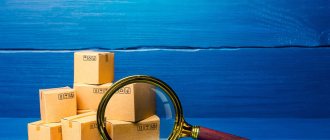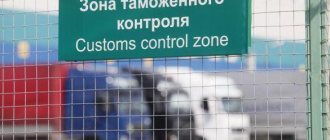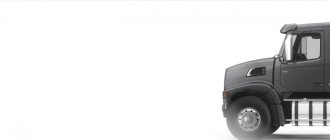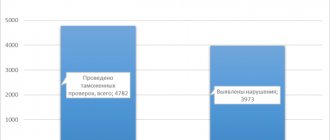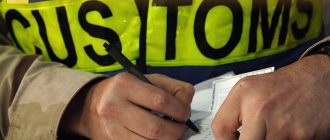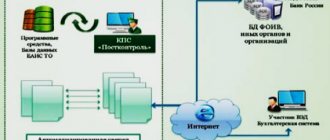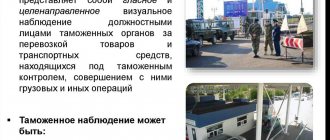HomeCustoms clearancecustoms control
Customs control (CC) is one of the main functions of customs authorities. It is associated with the prevention and suppression of violations of international, union and national legislation in the field of customs regulation. The executive authorities entrusted with the functions of customs control are the structural divisions of the Federal Customs Service of the Russian Federation: customs posts, customs houses, regional customs departments, departments of the Central Office of the Federal Customs Service of the Russian Federation (more details).
| Levels of customs authorities by competence in the field of customs control of goods | |
| Tactical | Grassroots level. Control at this level is carried out by customs posts and customs offices. They define areas of risk that are specific to short-term situations, specific individuals and specific cargo. |
| Operational | Average level. Control at this level is carried out by regional customs departments (RTU) of the Federal Customs Service of the Russian Federation. They determine local areas of risk in relation to individuals, goods or customs authorities, and distribute the competencies of subordinate units at the lower level. |
| Strategic | Highest level. Customs control is managed by the Federal Customs Service of the Russian Federation. Here, risk areas with the highest probability of potential violation of customs legislation and the greatest amount of damage in the event of risks are determined. Analysis of such risks allows us to further develop and implement measures to prevent violations of the law and minimize their consequences. |
The divisions of the Federal Customs Service of the Russian Federation have been assigned customs control goals.
Purposes of customs control
The main strategic goal of customs control is the protection of national economic interests; ensuring economic growth of Russia and its allies; creating favorable conditions for foreign investment; protecting the interests of national producers.
Purposes of customs control:
- Control over the movement of goods in accordance with the customs procedure specified in the declaration;
- Monitoring the use of goods in accordance with procedures;
- Monitoring the accuracy of the information declared by the declarant in the customs declaration;
- Monitoring compliance with all conditions and restrictions on the use and (or) disposal of conditionally released goods;
- Control over the legality of the actions of persons performing customs clearance.
Documents and information for customs clearance of cargo at the customs of the Russian Federation
- List of documents for registration of an individual at customs (View)
- List of documents for registration of a Legal entity at customs (View)
- List of documents for registration of an individual entrepreneur at customs (View)
- List of documents for customs clearance “Import” (View)
- List of documents for customs clearance “Export” (View)
Retrieval of documents
Inspectors have the right to get acquainted with accounting and reporting data, accounts, databases and data banks of the company’s automated systems, commercial documents and other information related to foreign economic and subsequent transactions with goods (Article 134 of the Labor Code of the Customs Union). Customs officers can only request documents in writing, but inspectors have the opportunity to get acquainted with the papers both on their territory and on the premises of the company. The head of the inspection team agrees on this issue with the company representative. If customs officers want to study the papers at their place, they must draw up a transfer and acceptance certificate and list in it all the documents that they plan to take away.
If there is not enough money in the company's accounts to pay the sanctions, customs officials have the right to recover payments from unpaid goods that have not yet been released for free circulation. In other cases, the head of customs may foreclose on other property of the company.
The Customs Code of the Customs Union does not establish a period during which a company is required to submit documents. It is determined by the auditors themselves. The main thing is that those being inspected have enough time to fulfill the requirement (clause 2 of article 98 of the Labor Code of the Customs Union). Please note: the verification period does not count towards the collection of papers. If you do not meet the time set by the inspectors, notify them in writing. If a claim is sent to you by mail, it will be deemed to have been received on the sixth day from the date of mailing. This means that you can add these days to the deadline set by the auditors. However, in such a situation, it is better to inform customs (at least by phone) about the extension of the period. Otherwise, inspectors may open an administrative case. Documents must be submitted in the form of copies certified by the seal and signature of the head of the company or entrepreneur. Otherwise, customs officers can draw up a protocol under Article 19.7 of the Code of Administrative Offenses of the Russian Federation. The decision on the fine is made by the court. The sanctions for a company will range from 3,000 to 5,000 rubles, for entrepreneurs and officials - from 300 to 500 rubles. Please note: if you do not submit documents during a desk inspection, customs officers will order an exit inspection; if the officials are again not satisfied, they may seize the goods.
Documents required for customs purposes must be kept for five years. If you do not have these papers, inspectors will most likely offer you to restore them. In case of refusal, auditors do not have the right to punish you, but there are no clearly defined sanctions for this in the law. But in such a situation, they can independently calculate the amount of payments subject to collection by customs. At the same time, they will be fined for late payment under Article 16.22 of the Code of Administrative Offenses of the Russian Federation.
Features of customs control of goods
Officials can initiate a TC immediately after the goods are imported into the customs territory. When exporting, the TC can be started immediately after registration of the declaration. What is checked during TC: goods and documents; information received; time and compliance with deadlines for customs procedures; activities of persons involved in operations.
The following are subject to customs control:
- Goods transported across the customs border (including commercial consignments of goods, personal belongings of citizens, cars, international mail);
- Documents relating to goods and vehicles under customs control;
- Deadlines for completing procedures in relation to goods under customs control and operations with such goods (for example, compliance by the carrier with established deadlines for the transit of goods);
- Vehicles for the international transportation of goods (trucks, trains, ships and aircraft, various types of transport packaging (containers, wagons, etc.));
- Information relating to goods and vehicles under customs control;
- Activities of persons performing customs operations (individuals, legal entities (carriers, customs brokers, authorized economic operators, temporary storage warehouse owners, etc.)).
Interim act
Having discovered signs of a crime during an inspection, inspectors are required to transfer the materials to the police or customs law enforcement unit to initiate a criminal case. If an administrative violation is found, inspectors must draw up a report or initiate (and conduct) an administrative investigation.
In addition, auditors are required to immediately draw up an interim report (at the time of detection of a violation or crime), in which they preliminarily calculate the amounts of customs duties payable. Having sent this document to the head of customs, inspectors continue the inspection.
Carrying out customs control
The procedure for carrying out customs control and what is its duration?
It all depends on the chosen form of TC. Checking documents, examining or interviewing an individual rarely takes much time. As a rule, it only takes a few minutes for an experienced inspector to separate from the entire mass of incoming goods and accompanying documents those goods transported in violation of the law. The inspection can last several hours (its duration depends on the amount of cargo being inspected, the number of inspection personnel, available technical equipment, the number or complete absence of forklifts, cranes and other loading and unloading equipment). But even when the goods have been successfully released, this does not mean that control has been completed. In recent years, the Federal Customs Service of the Russian Federation has done a lot to gradually shift the emphasis of customs control from the stage preceding the release of goods to the stage following the release. This should help make the process of clearing goods through customs as easy as possible for participants in foreign trade activities, reduce its time, get rid of queues at customs and unnecessary downtime of transport. Inspectors have the right, for three years from the date of release of goods, to raise the issued declarations, verify the data stated in them, request additional documents from the declarant, or make a request to various regulatory authorities (Federal Tax Service of the Russian Federation, Ministry of Industry and Trade, Rosselkhoznadzor, Rosalkogolregulirovanie, FSB of the Russian Federation, etc.). This is a desk check (in other words, a desk check). If it reveals a discrepancy between the data stated in the DT and the actual facts (for example, a foreign trade participant sold more foreign goods than he indicated in the DT), then an on-site inspection is carried out. Sometimes specialists from the Federal Tax Service of the Russian Federation, Rosselkhoznadzor, FSTEC of the Russian Federation, the prosecutor's office and other government agencies of supervision and control are involved in it.
Seizure and seizure of goods
Customs officers can seize products if they find:
- that the goods do not have special marks or other means of designation confirming that they were imported into Russia legally;
- that the company’s documents do not contain information about the release of goods or this information is unreliable;
- that the company uses conditionally released goods for purposes other than those for which it was exempted from paying customs duties.
Keep in mind: before seizing or seizing goods, customs officers are required to present a resolution on this and invite two witnesses, and then draw up a protocol. The procedure is carried out in the presence of a representative of the company or entrepreneur.
The seized property is transferred to the storage of its owner. He can use them if he receives permission from the head of customs. Inspectors have the right to seize seized goods if they doubt their safety (Part 4 of Article 183 of the Law on Customs Regulation in the Russian Federation). Inspectors are required to seize goods prohibited for import or circulation in Russia in any case.
Keep in mind: before seizing or seizing goods, customs officers are required to present a resolution on this and invite two witnesses, and then draw up a protocol. The procedure is carried out in the presence of a representative of the company or entrepreneur.
Carrying out customs control after the release of goods
Carrying out customs control after the release of goods (TCPVT) is the actions of customs authorities aimed at identifying and preventing violations of the law. This type of control is carried out after crossing the customs border and is called “subsequent”. To carry it out, a special customs department was established in 2012. Subject to verification:
- the reliability of the information declared when declaring goods;
- targeted use of goods and compliance with restrictions in cases related to conditional release, with the provision of benefits for the payment of customs duties.
All information provided is compared with that obtained from accounting audits, reports, bank transactions and other information. According to Art. 311 of the EAEU Customs Code, not only goods and documents are subject to customs control, but also the activities of persons providing customs services, for example, a declarant or a customs representative, as well as the activities of temporary storage warehouses and duty-free shops. The purpose of customs control is to identify violations, protect the domestic market of the Russian Federation, and prevent illegal trafficking of goods. During the control, violations are revealed for significant amounts amounting to billions, and tons of goods are seized and destroyed from illegal traffic. In addition, during TKPVT they carry out other forms of verification: they monitor compliance with legal requirements for mandatory labeling of goods. The mandatory labeling of goods introduced in Russia makes it possible to solve problems related to the prevention of illegal circulation of goods, counterfeiting and smuggling.
Duration of customs control after the release of goods
The period for carrying out customs control after the release of goods for domestic consumption is carried out until the expiration of 3 years. In addition, customs authorities, according to the EAEU Customs Code, have the right to carry out control before the expiration of the period that the goods are “under customs control.” This period may continue, according to Art. 14 of the EAEU Labor Code, before the occurrence of various circumstances, for example, before acquiring the status of “goods of the union”, before the goods are exported from the customs territory, destroyed, before the goods are recognized as production losses, before the goods are declared unsuitable for commercial use, before the completion of the transit procedure and some others. In addition, TKVT can be carried out regarding goods released conditionally. A procedure has been established by law to ensure the exchange of information between customs and tax authorities and internal affairs bodies. Customs control after the release of goods can be carried out if violations of customs legislation are detected.
Problems of customs control after the release of goods
The problems of carrying out customs control after the release of goods are associated with the need to increase the efficiency of customs control in general. It is necessary to raise the level of customs control so that violations of the law lose their economic viability. For this purpose, methods and forms of customs control are selected. The creation of a continuous monitoring system will reduce waiting time at the border.
Personal customs inspection
An exceptional method applied to individuals in situations where customs officials have reason to suspect that entities crossing territorial borders are deliberately concealing goods transported in violation of current legislation. From a legal point of view, this is one of the most carefully regulated procedures, since it actually affects the fundamental constitutional right of an individual to the integrity of the person.
Factors that serve as reasons for applying this type of control by customs authorities include:
- Information about hidden objects.
- Information confirming the fact of transfer of items from the main territory to the transit territory, or in the opposite direction.
- Operational reports notifying about planned illegal shipments related to the transportation of goods withdrawn from free circulation.
The right to make a final decision remains with the head of the body (in case of absence, with his immediate deputy), and is exercised in writing: through the preparation of a separate act, or by imposing a resolution on the incoming report.
Customs inspection after release of goods
Customs inspection after the release of goods is an effective tool for monitoring compliance by foreign trade participants with customs legislation. Customs inspection after the release of goods of the EAEU Customs Code in Article 331 is defined as a form of customs control carried out by customs authorities along with other forms. Forms of customs control are listed in Article 322 of the EAEU Labor Code, including customs inspection. Inspections can be both desk and on-site; on-site inspections, in turn, can be scheduled, unscheduled and counter. The period of customs inspection after the release of goods is limited to 3 years, but customs documents must be kept for 5 years.
On-site customs inspection, example after the release of goods: among the imported goods sold by a trade organization, the inspection revealed a product labeled as imported, but of Russian origin.
The effectiveness of customs checks after the release of goods is quite high. As a result of their implementation, violations are identified and administrative and criminal cases are initiated, as a result of which customs payments, fines and penalties are transferred to the federal budget. The results of inspections must be documented as customs inspection reports after the release of goods in a legally approved form. If the audit establishes the fact of an unreliable declaration, then a copy of this document must be sent to the declarant.
How is the verification carried out?
During the on-site inspection, customs officers can: inspect goods, premises and territory of the company, carry out an inventory of goods according to rules similar to tax inspectorates, arrest and seize goods, receive explanations, check labeling, order an examination of goods, attract specialists, take samples and samples, and also use means to identify goods.
Keep in mind: customs officers have the right to carry out each of these actions not only as part of the inspection, but also separately. The activities planned by inspectors must be listed in the decision to conduct an on-site inspection. The court may recognize correctly completed audit results as evidence in criminal and administrative cases (Article 134 of the Customs Code of the Customs Union).
Customs control zone
The customs control zone (CZZ) is a separated, fenced from other space, protected area where customs control activities are carried out. On the territory of the ZTC there are areas for open-air cargo storage, truck parking, warehouses, administrative buildings, and a customs building. Access for citizens and transport is provided only through organized checkpoints. TC zones are either permanent (PZTK) or temporary (VZTK). PZTK are available at major airports, border checkpoints (road and railway), in warehouses (customs and temporary storage warehouses), and free economic zones. PZTK are established to control the import and export of seasonal goods, as well as dangerous or large goods (transportation to the PZTK is problematic/impossible).
In the ZTC, inspectors can stop transport, inspect cargo, and perform other actions. Outside the ZTC, inspectors are also authorized to stop vehicles, but accompanied by traffic police officers.
Example
Customs officers conducted an inspection at Passiv LLC regarding the possible sale of undeclared computer equipment stored in the company's warehouse. The inspectors did not find any documents confirming this fact. The director of the company stated that all undeclared computer equipment stored in their warehouse was stolen.
Then customs officers inspected the personal computers of the company's employees. A specialist in programming and computer technology participated in the inspection. It was he who discovered and recovered a deleted email message in which the company being audited offers entrepreneur Sergeeva to purchase computer equipment. Its characteristics (factory and serial numbers, manufacturer, etc.) coincided with the allegedly stolen computer equipment.
Through the tax office, customs officers found the entrepreneur Sergeeva and conducted a counter check on her. As a result, documents were found confirming that the entrepreneur purchased computers of the appropriate characteristics from Passiv LLC. Sergeeva confirmed this fact.
Customs officers fined the company under Article 16.21 of the Code of Administrative Offenses of the Russian Federation for selling undeclared goods.
The procedure for customs control
On the territory of the ZTC, customs authorities are authorized to carry out any forms of control.
Forms of customs control:
- Request and receipt of explanations from participants in foreign trade activities;
- Checking documents and information;
- Customs inspection of goods and transport;
- Customs inspection of goods and transport;
- Personal customs inspection;
- Inspection of premises and territories for customs control purposes;
- Customs check.
Receiving explanations. The inspector has the right to request additional information, receive an explanation from individuals and legal entities in order to clarify the information specified in the DT. If the interviewee has information of interest to the inspector, then he must provide it to the inspector.
Checking documents and information. The inspector needs to determine that:
- All formalities have been observed when declaring;
- All seals and stamps are present and comparable to samples;
- The documents provided on numbered forms are not stolen, not canceled and are valid (the inspector can make requests through the system of interdepartmental interaction with other departments (SMEV) to search for documents of interest in databases);
- The DT and shipping documents contain no traces of uncertified corrections, erasures, additions of text, or forgery of a seal or signature.
If necessary, the inspector has the right to reasonably request additional information from the declarant. The received documents are sent for verification (the period can range from several hours to one month).
Customs inspection (CI) and customs inspection (CD). TC consists of a visual inspection of goods, luggage, vehicles, mail and documents for them. Differences between TO and TD: during inspection, the cargo compartment of a vehicle, container, or luggage is not opened, but during inspection they are opened and the goods are removed. Therefore, TD is a more complete form of TC. Why then does customs use such an imperfect control method as inspection? The reason is that TD is a more labor-intensive and expensive form of TC. It is impractical to inspect the entire flow of goods.
The purpose of the TO is to make sure that the data declared in the DT truly describes the goods presented to customs. If there are customs seals on a container, luggage, or other transport packaging, the inspector must verify their integrity and that the cargo has not been opened (there are no signs of disassembly or dismantling).
During maintenance, inspectors often use technical means of customs control (TCC) of different classes (from simple to complex). Complex TSTCs include X-ray installations, gas analyzers, and inspection and inspection complexes (IDC). A few words about IDK. With their help, transport containers, luggage, and cargo compartments of cars are inspected. This is done in order to establish, based on the analysis of the received X-ray images, the quantity of goods in the container, its nature, and, if there are extraneous attachments, to identify them (the bulk of the goods and extraneous attachments are made of different materials, have different dimensions, different densities, and therefore X-ray images will differ from each other), identify hiding places and stashes of contraband.
The presence of the declarant at the inspection is not required. TD of goods occurs only in the presence of a foreign trade participant.
Degrees of customs inspection
- Recalculation of cargo packages with selective opening;
- Weighing (full or selective);
- Recalculation of the number of items in cargo packages selectively;
- Recalculation of cargo packages with opening of all packages;
- Measuring and determining the characteristics of goods (with partial or complete disassembly):
- No sampling or sampling;
- With taking samples and specimens;
- Recalculation of the number of items in all cargo packages.
The extent and depth of TD is determined by the head of customs. But, if necessary, the inspector can increase it. Reducing the volume and degree of TD is unacceptable.
What can cause a TD? Let's try to talk about some of them.
- First of all, these are the results of maintenance. If the inspector found damaged seals, traces of opening a sealed container, and an inspection using the IDK revealed foreign attachments in the car, then he can send a memo to the head of the post about conducting a TD of the cargo that aroused suspicion, indicating the depth of the inspection.
- Suspicions about the authenticity of the documents presented by the declarant at customs, errors made in them.
- Another factor is the triggering of a certain risk profile in the risk management system (RMS). We will talk about the work of the RMS a little later.
The result is an act drawn up by the inspector (a copy is handed over to the foreign trade participant).
Personal customs inspection is an exceptional form of control, because the inspection affects the personal rights and freedoms of the citizen. However, customs officers are forced to resort to random inspection of citizens, since there are still frequent cases when offenders tried to secretly smuggle goods across the state border on their body, in clothing, or among personal belongings. In any case, almost every one of us has seen crime news reports, which periodically talk about the detention at the border of individuals who were trying to secretly smuggle contraband.
What do you need to know about the features of personal search of citizens?
- The decision on the LTD of a particular citizen is not made by the inspector alone. A positive resolution from the head of customs is required. Only he has the right to approve and sign the LTD document. Let's consider a possible scenario. During an inspection, passport check, DT, or interview of an individual, the inspector discovers signs that the citizen is hiding some goods on him and tries to move them outside of control. The inspector draws up a report addressed to the head of customs, where he indicates the signs of the offense being committed. Based on the official document, the head of the post approves the decision to conduct LTD of an individual.
- A personal search of an individual is carried out at the ZTK. The procedure must take place in a separate special room that meets all standards (sanitary, hygienic) and is inaccessible to unauthorized persons.
- Customs notifies the citizen that it has accepted the start of inspection activities. The citizen is informed of his rights, after which he puts his signature on the form of the Decision to conduct a personal customs inspection. The citizen has the right to refuse to sign the decision, then the inspector writes down information that the person being inspected was notified of the LTD, his rights were announced to him, he was asked to independently hand over the illegally transported goods, and he refused to sign the document.
- The law clearly states: the inspector’s actions must not infringe on the honor and dignity of a citizen, cause harm to his health or damage to property.
- Attesting witnesses are brought to the LTD as witnesses. Inspection measures regarding a minor child (or an incapacitated person) require the presence of at least one of the parents (guardians). An important condition: the inspector, witnesses, and those being examined must be gender equal, that is, belong to the same sex. An examination of an individual’s body is carried out by a health worker. The operations are performed by him using special tools and medical equipment.
- The inspected citizen is obliged to comply with all lawful instructions of the inspector.
- After completion, the LTD is drawn up, signed by the inspector, the inspected citizen (his representative), witnesses and a medical worker. One copy of the document is handed over to the inspected citizen.
The inspector must remember that FTD of citizens is an interference in a person’s personal space, and therefore requires maximum compliance with ethical and moral standards. The following rules are not enshrined in law, but they should be discussed.
- If necessary, a citizen has the right to ask the inspector to allow an interpreter to see him;
- LTD is carried out by the inspector in the correct form, without humiliating the dignity of the individual, causing unlawful harm to the health and property of the person being inspected (to the extent necessary to detect goods hidden by a citizen on his or her person);
- It is prohibited to comment on the behavior of the person being searched, his possible physical disabilities, clothing, etc., etc.
- Filming, video and photography are carried out until the moment when the command is given to begin removing clothes.
A citizen has the right to make statements, petitions and include them in the act (independently or with the help of an inspector), and to appeal the actions of a customs officer.
Inspection of premises and territories for the purposes of customs control implies a visual inspection of premises and territories, as well as goods and documents. Customs authorities must ensure the presence of goods under control (including conditionally released ones), as well as the integrity of customs seals and seals on vehicles carrying goods under the transit procedure.
Inspection of premises and territories is carried out only on the basis of an order to carry out maintenance and inspection, signed by the head of the post. The form on which the order is issued must have its own serial number and contain information about the date of the inspection, the name of the object of inspection, the full name of the inspector, the number of his certificate, a note about the acquaintance of the person whose premises and territories are planned to be inspected (hereinafter referred to as the “owner/tenant”) .
Before carrying out the inspection, the inspector presents the owner/tenant with the Order and his identification. It is not recommended to obstruct the inspector, since he has the right to suppress resistance and open closed premises. Opening of locked doors must be carried out in the presence of witnesses and with notification of the prosecutor.
Duration of MOP is no more than 1 working day. day. Upon completion of the event, the inspector draws up a maintenance and inspection report, one copy of which is given to the owner (tenant).
Customs inspection is carried out:
- At temporary storage warehouses, customs warehouses, in the premises of duty-free shops to check their compliance with legal requirements, as well as to check the conditions for the presence of goods under customs control on their territories;
- At checkpoints across the state border, in customs control zones, premises located here, the territories of individuals, if there is information about goods and vehicles imported in violation of customs legislation, to verify such information;
- On the territories and premises of persons storing and disposing of goods under customs control. For example, upon receipt of information that such goods have been lost or are used and stored in violation of customs legislation, to verify such information.
Customs inspection (CI) is carried out after the goods are released. Its purpose is to make sure that the declarant (UChVED, carrier, owner of the temporary storage warehouse, AEO) complies with the legislation, in particular the conditions of the customs procedure declared during registration. Employees of various regulatory authorities (prosecutor's office, Federal Tax Service of the Russian Federation, specialists from Rosselkhoznadzor, etc.) can take part in the TC.
Inspectors compare the data reflected in accounting and statutory documents with the information stated in the DT and shipping documents.
When implementing control measures, the customs authority has the right to apply the following measures:
- Conduct an oral survey;
- Request and receive necessary documents and information;
- Identify goods, vehicles, premises, territories;
- Use technical means;
- Carry out customs escort of goods under control and vehicles for their delivery;
- Develop a route for the transportation of goods under customs control;
- Keep records of goods under customs control and customs operations performed with them;
- Invite specialists to implement customs control measures;
- Conduct customs surveillance.
The essence and types of procedures
The oral survey is represented as a separate form of control at customs. It is used in the case of clearance of goods and transport at customs. The essence of the procedure is for customs authorities to receive the required information from individuals authorized regarding transported goods and transport of citizens orally. Explanations do not require written documentation.
There is a limitation to oral questioning through customs clearance, which is determined by the movement of products and vehicles across the border.
Technical means of customs control
To increase efficiency, reduce time and labor costs when carrying out customs control, technical means of customs control (TCC) can be used: instruments, instruments, devices. The procedure for their use is regulated by law. Most often, special mirrors, videoscopes, probes and X-ray units are used. The variety of TSTK is very large, this is due to the sophistication of smugglers trying to smuggle cargo secretly. Technology is constantly being improved, new means and new ways of detecting contraband are appearing. But, as before, an ordinary tape measure and scales are actively used. Complex devices allow you to quickly determine the composition of the material from which jewelry is made.
Customs control system
The organization of customs control in the Russian Federation is based not only on the customs legislation of the EAEU and national legislation, but also on international treaties that our country has ratified.
The Kyoto Convention on the Simplification and Harmonization of Customs Procedures proclaims the principle of openness of world trade and calls on the countries of the world to create conditions under which foreign trade turnover and legal trade would be accelerated. Customs authorities around the world must ensure the development of international trade without compromising the effectiveness of customs control. The principles proclaimed by the Kyoto Convention became fundamental for the World Customs Organization (WCO), of which the Russian Federation is a member.
It is possible to achieve acceleration of processes in foreign trade turnover through the widespread introduction of automation processes in the procedure for registering goods, the introduction of electronic document flow between participants in foreign trade activities, and also by simplifying the control of goods. International experience of customs organizations suggests that it is quite possible to abandon total control of all flows of goods and replace it with selective control. The customs administrations of European countries reached the point that only 10-15% of the total trade flow was inspected.
In Russia, selective control of goods is also used. That is, not all consignments are inspected (and even this is impossible), but only a part of them. Which product batch will be subject to control measures is determined by the Risk Management System (RMS). Thanks to the algorithms introduced into the system, Russian customs authorities managed to reduce the time required to complete customs procedures and reduce queues at checkpoints.
The RMS operation algorithm is as follows: the system assigns a so-called risk profile to each product batch. The choice of one or another form of customs control depends on the risk profile. In relation to one part of the consignments, such customs control measures as document verification and customs inspection are applied, and in relation to the other part of the consignments, customs inspection measures are applied. And even if the goods have been successfully released by customs under the declared customs procedure, the RMS system can assign measures for customs inspection of premises and territories where customs cleared goods will be placed, and can assign a measure of customs inspection (desk or on-site).
When forming risk profiles, the RMS system analyzes many parameters. They can be divided into external and internal.
Internal includes information recorded in customs databases (world average prices for different groups of goods, average contract amounts for certain goods, declaration databases, information catalogs issued by customs and non-customs authorities, customs statistics and other sources of information). External sources include information received by customs authorities from databases of other executive authorities (from the Federal Tax Service of the Russian Federation, the Ministry of Industry and Trade, Rosalkogolregulirovanie, Rosselkhoznadzor). For this purpose, the capabilities of the SMEV system are actively used. External sources also include information received by Russian customs authorities from customs authorities of other states through international cooperation channels.
The exact number of parameters influencing the formation of risk profiles is not known. According to some information, the RMS system operates about one and a half thousand different parameters when determining the risk profile of a particular product batch, and this number is constantly increasing. What these parameters are is also not known. Based on experience, it can be assumed that the risk profile is influenced by the following parameters.
- Country (region) of origin of the product. Most often, consignments of goods arriving from countries for which goods from which Russia applies so-called counter-sanctions (Ukraine, the USA, EU countries) are subject to inspection. Also, a high risk profile is assigned to goods consignments arriving in our country from regions where there is war or regions with a high level of drug crime.
- Commodity code of goods according to the Commodity Nomenclature of Foreign Economic Activity. Most goods are freely imported and exported from the country, but there are a number of goods for export or import of which you will need to present a license, certificate, declaration, or permit at customs. Some unscrupulous participants in foreign trade activities, in violation of customs legislation, assign a different commodity code to the declared goods. A similar method is used by foreign trade participants to avoid paying duties. The RMS system has information about groups of goods that are most often subject to incorrect declaration. Russian customs authorities often use contacts with colleagues from other countries. If discrepancies are detected between the volumes of exports and imports of certain goods, they also fall into the risk group.
- Foreign trade participant, declarant. The RMS system considers all declarants as bona fide participants in foreign economic activity. However, once a declarant makes a mistake (intentionally or unintentionally), which led to the initiation of an administrative case (without deprivation of a license), all subsequent foreign trade operations of this foreign trade participant will be considered by the RMS system as high-risk. Participants in foreign trade activities with the status of an authorized economic operator, bona fide customs representatives, owners of temporary storage warehouses, customs warehouses, and duty-free shops have the lowest risk profile.
- Number of goods. There is a group of so-called cover goods that serve as a cover for the import of risk goods into the country. Suspicion is raised by large quantities of potato starch, products used to feed animals, timber and other categories of goods, which may be a cover for the import of high-risk goods, or even those prohibited for import or export, smuggling.
- Goods imported using documents whose authenticity is questionable. A high risk profile can be assigned to a consignment that is imported accompanied by certificates, licenses, declarations and other documents, the reliability of which is questionable.
- Route of movement of goods. The degree of risk depends on how high the risk of transhipment of goods under customs control is.
There are other factors that influence the formation of a risk profile. The system does not stand still, it is being improved, and the number of factors that influence the risk profile is growing. The introduction of the RMS system made it possible to make customs operations more transparent and predictable, and to achieve a balance between ensuring security and measures promoting the development of trade and partnership between customs and business.
We do not recommend that foreign trade participants try to test the Risk Management System and violate customs legislation. If during the inspection undeclared or smuggled goods are revealed, it turns out that part of the goods under customs control was unloaded, or facts of false declaration are revealed, then an administrative case may be initiated against the foreign trade participant. We recommend that foreign trade participants use the services of bona fide declarants, customs representatives, temporary storage warehouses, and customs warehouses.
Receiving explanations
During the control event, customs officers may require written explanations from company employees (Article 113 of the Labor Code of the Customs Union). Keep in mind: this is not about testimony in an administrative or criminal case, but about clarifying and clarifying some nuances that arise during the verification process. If inspectors start asking you questions about the circumstances of the violation or crime, you can refuse them. To collect such information, there are procedures established in the Code of Administrative Offenses of the Russian Federation and the Code of Criminal Procedure of the Russian Federation. Remember that you have the right not to testify against yourself and your loved ones (Article 51 of the Constitution of the Russian Federation).
The court has the right to use explanations as evidence in a criminal or administrative case (Article 171 of the Law on Customs Regulation in the Russian Federation). For refusal to give explanations, a fine is provided for entrepreneurs and company officials in the amount of 300 to 500 rubles, for other employees - from 100 to 300 rubles (Article 19.7 of the Code of Administrative Offenses of the Russian Federation).
To check whether the information about goods declared during declaration corresponds to the actual data, auditors can conduct a customs inspection. The Customs Code of the CU provides for two forms of this event: customs inspection (Article 115 of the CU Labor Code) and customs inspection (Article 116 of the CU Labor Code). If inspectors do not need to open vehicles or break the packaging of goods, then they will conduct a customs inspection, and if they need to carry out a more detailed study, then this will be called a customs inspection. The entrepreneur or head of the company or their representatives must be present during the inspection. If for some reason they cannot be near the auditors, then the inspectors are required to invite two witnesses (clause 6 of Article 116 of the Labor Code of the Customs Union).
Usually, not all goods are inspected, but approximately 10 percent of the total number of each item. If customs officers discover violations, they will check the property to a greater extent.
Usually, not all goods are inspected, but approximately 10 percent of the total number of each item. If customs officers discover violations, they will check the property to a greater extent.
During the inspection, customs officers may tear, break, saw off, etc. goods and their packaging, opening and disassembling vehicles. However, such actions are not always required. As a rule, inspectors make do with partial unpacking of the property being inspected. A customs inspection can be carried out for a specific purpose - to find property prohibited (restricted) for import or moved with concealment from customs control. Inspectors usually obtain information about such a product operationally, that is, with the help of their agents, random interception of information, etc. Although sometimes the “offending product” is discovered at the customs border. After the inspection, inspectors must draw up a report.
Customs control services
Ours provides services for passing customs control and the services of a customs broker - representative of any participants in foreign trade activities at any customs houses and customs posts in Russia.
We provide the following types of services:
- Assistance in collecting shipping documents (certificates of conformity, certificates of origin, declarations of conformity, etc.);
- Filling out and submitting a customs declaration;
- On behalf of the client, we represent his interests at the temporary storage warehouse and customs, and are present at customs inspections and inspections;
- We calculate customs duties and, on the client’s instructions, pay them to customs.
We work with all participants in foreign trade activities:
- Individuals
- Legal entities
- Individual entrepreneurs
Taking samples
Most often, inspectors take samples of goods when conducting an inventory or inspection in order to determine the place of origin, brand, grade, quality, composition, properties of the goods, whether they are narcotic or psychotropic substances, etc. Samples and specimens are taken in a minimum quantity sufficient to analyze them.
An entrepreneur or a company representative has the right to be present during the selection. However, customs officers can hold this event without them, but by inviting two witnesses (Article 144 of the Labor Code of the Customs Union). The selection of samples is documented in an act.
